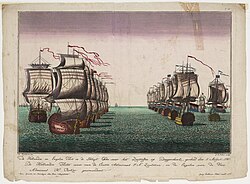HMS Fortitude (1780)
 Fortitude
| |
| History | |
|---|---|
| Name | HMS Fortitude |
| Ordered | 2 February 1778 |
| Builder | Randall, Rotherhithe |
| Laid down | 4 March 1778 |
| Launched | 23 March 1780 |
| Honours and awards |
|
| Fate | Broken up, 1820 |
| General characteristics [1] | |
| Class and type | Albion-class ship of the line |
| Tons burthen | 1645 bm |
| Length | 168 ft (51 m) (gundeck) |
| Depth of hold | 18 ft 10 in (5.74 m) |
| Propulsion | Sails |
| Sail plan | Full-rigged ship |
| Armament |
|
HMS Fortitude was a 74-gun third-rate ship of the line of the Royal Navy, built by John Randall & Co. and launched on 23 March 1780 at Rotherhithe.[1]

Under Captain
French Revolutionary Wars
In 1793, under Captain
On 7 February 1794 Fortitude, under the command of Captain William Young, and
Under Captain Thomas Taylor Fortitude was involved in actions off
On 25 September 1795, Fortitude set sail for Britain with a large convoy. On 7 October 1795 the convoy sighted a large French squadron, off Cape St. Vincent, which sailed in pursuit of them. Before the French arrived, Censeur lost her fore topmast and had only a frigate's main mast left, rendering her useless. She was also lightly manned and short of powder. In the subsequent exchange the French recaptured Censeur, along with 30 ships of the convoy. The rest continued on to England.[4]
Fate
Fortitude served as a prison ship from 1795 and as a powder hulk at Portsmouth from 1802. She was broken up there in 1820.[1]
Citations and notes
- ^ a b c Lavery, Ships of the Line, vol. 1, p. 180.
- ^ "Engagement with the French off Ushant (History of HMS Victory)". Archived from the original on 22 July 2011. Retrieved 2 January 2010.
- ^ "No. 13631". The London Gazette. 11 March 1794. pp. 221–223.
- ^ "No. 13823". The London Gazette. 17 October 1795. pp. 1074–1075.
References
- Lavery, Brian (1983) The Ship of the Line - Volume 1: The development of the battlefleet 1650-1850. Conway Maritime Press. ISBN 0-85177-252-8.
- Winfield, Rif (2008). British Warships in the Age of Sail 1793–1817: Design, Construction, Careers and Fates. Seaforth. ISBN 978-1-84415-717-4.
External links
 Media related to HMS Fortitude (ship, 1780) at Wikimedia Commons
Media related to HMS Fortitude (ship, 1780) at Wikimedia Commons
